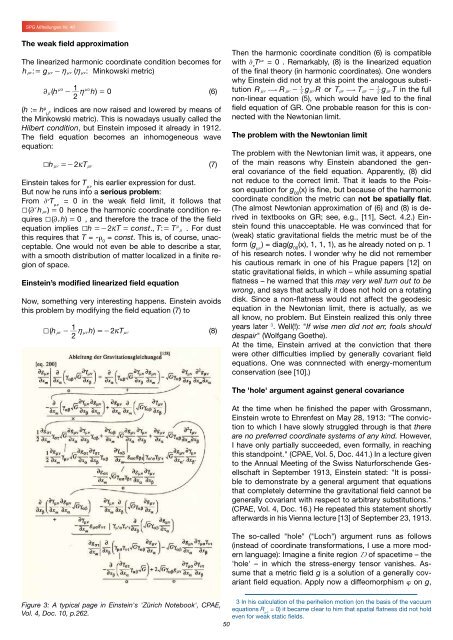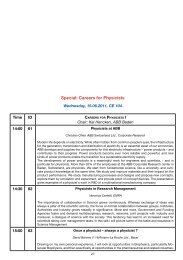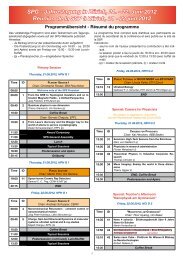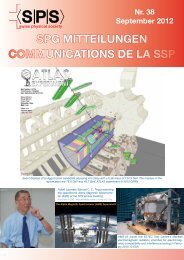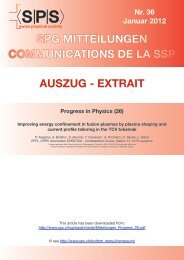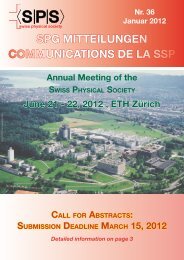spg mitteilungen communications de la ssp - Schweizerische ...
spg mitteilungen communications de la ssp - Schweizerische ...
spg mitteilungen communications de la ssp - Schweizerische ...
Create successful ePaper yourself
Turn your PDF publications into a flip-book with our unique Google optimized e-Paper software.
SPG Mitteilungen Nr. 40<br />
The weak field approximation<br />
The linearized harmonic coordinate condition becomes for<br />
h no: = g no - hno ( hno : Minkowski metric)<br />
na<br />
( h<br />
1 na<br />
2n<br />
- h h)<br />
= 0<br />
(6)<br />
2<br />
(h := h μ , indices are now raised and lowered by means of<br />
μ<br />
the Minkowski metric). This is nowadays usually called the<br />
Hilbert condition, but Einstein imposed it already in 1912.<br />
The field equation becomes an inhomogeneous wave<br />
equation:<br />
Xh<br />
=-2lT<br />
no no (7)<br />
Einstein takes for T mn<br />
his earlier expression for dust.<br />
But now he runs into a serious problem:<br />
From n T mn<br />
= 0 in the weak field limit, it follows that<br />
o<br />
X( 2 h no ) = 0 hence the harmonic coordinate condition requires<br />
X( 2 o h)<br />
= 0 , and therefore the trace of the the field<br />
equation implies Xh =- 2lT = const., T:<br />
= T<br />
n n . For dust<br />
this requires that T = -r 0<br />
= const. This is, of course, unacceptable.<br />
One would not even be able to <strong>de</strong>scribe a star,<br />
with a smooth distribution of matter localized in a finite region<br />
of space.<br />
Einstein’s modified linearized field equation<br />
Now, something very interesting happens. Einstein avoids<br />
this problem by modifying the field equation (7) to<br />
X( h -<br />
1<br />
h h)<br />
=-2lT<br />
2<br />
no no no (8)<br />
Then the harmonic coordinate condition (6) is compatible<br />
with n<br />
T mn = 0 . Remarkably, (8) is the linearized equation<br />
of the final theory (in harmonic coordinates). One won<strong>de</strong>rs<br />
why Einstein did not try at this point the analogous substitution<br />
R no $ R no - 2 g no R or Tno $ Tno - 2 g no T in the full<br />
1<br />
1<br />
non-linear equation (5), which would have led to the final<br />
field equation of GR. One probable reason for this is connected<br />
with the Newtonian limit.<br />
The problem with the Newtonian limit<br />
The problem with the Newtonian limit was, it appears, one<br />
of the main reasons why Einstein abandoned the general<br />
covariance of the field equation. Apparently, (8) did<br />
not reduce to the correct limit. That it leads to the Poisson<br />
equation for g 00<br />
(x) is fine, but because of the harmonic<br />
coordinate condition the metric can not be spatially f<strong>la</strong>t.<br />
(The almost Newtonian approximation of (6) and (8) is <strong>de</strong>rived<br />
in textbooks on GR; see, e.g., [11], Sect. 4.2.) Einstein<br />
found this unacceptable. He was convinced that for<br />
(weak) static gravitational fields the metric must be of the<br />
form (g mn<br />
) = diag(g 00<br />
(x), 1, 1, 1), as he already noted on p. 1<br />
of his research notes. I won<strong>de</strong>r why he did not remember<br />
his cautious remark in one of his Prague papers [12] on<br />
static gravitational fields, in which – while assuming spatial<br />
f<strong>la</strong>tness – he warned that this may very well turn out to be<br />
wrong, and says that actually it does not hold on a rotating<br />
disk. Since a non-f<strong>la</strong>tness would not affect the geo<strong>de</strong>sic<br />
equation in the Newtonian limit, there is actually, as we<br />
all know, no problem. But Einstein realized this only three<br />
years <strong>la</strong>ter 3 . Well(!): "If wise men did not err, fools should<br />
<strong>de</strong>spair" (Wolfgang Goethe).<br />
At the time, Einstein arrived at the conviction that there<br />
were other difficulties implied by generally covariant field<br />
equations. One was connnected with energy-momentum<br />
conservation (see [10].)<br />
The 'hole' argument against general covariance<br />
At the time when he finished the paper with Grossmann,<br />
Einstein wrote to Ehrenfest on May 28, 1913: "The conviction<br />
to which I have slowly struggled through is that there<br />
are no preferred coordinate systems of any kind. However,<br />
I have only partially succee<strong>de</strong>d, even formally, in reaching<br />
this standpoint." (CPAE, Vol. 5, Doc. 441.) In a lecture given<br />
to the Annual Meeting of the Swiss Naturforschen<strong>de</strong> Gesellschaft<br />
in September 1913, Einstein stated: "It is possible<br />
to <strong>de</strong>monstrate by a general argument that equations<br />
that completely <strong>de</strong>termine the gravitational field cannot be<br />
generally covariant with respect to arbitrary substitutions."<br />
(CPAE, Vol. 4, Doc. 16.) He repeated this statement shortly<br />
afterwards in his Vienna lecture [13] of September 23, 1913.<br />
The so-called "hole" ("Loch") argument runs as follows<br />
(instead of coordinate transformations, I use a more mo<strong>de</strong>rn<br />
<strong>la</strong>nguage): Imagine a finite region D of spacetime – the<br />
'hole' – in which the stress-energy tensor vanishes. Assume<br />
that a metric field g is a solution of a generally covariant<br />
field equation. Apply now a diffeomorphism on g,<br />
Figure 3: A typical page in Einstein's 'Zürich Notebook', CPAE,<br />
Vol. 4, Doc. 10, p.262.<br />
50<br />
3 In his calcu<strong>la</strong>tion of the perihelion motion (on the basis of the vacuum<br />
equations R mn<br />
= 0) it became clear to him that spatial f<strong>la</strong>tness did not hold<br />
even for weak static fields.


